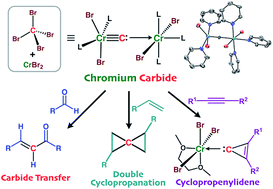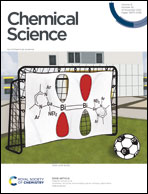Chromium carbides and cyclopropenylidenes†
Abstract
Carbon tetrabromide can be reduced with CrBr2 in THF to form a dinuclear carbido complex, [CrBr2(thf)2)][CrBr2(thf)3](μ-C), along with formation of [CrBr3(thf)3]. An X-ray diffraction (XRD) study of the pyridine adduct displayed a dinuclear structure bridged by a carbido ligand between 5- and 6-coordinate chromium centers. The carbido complex reacted with two equivalents of aldehydes to form α,β-unsaturated ketones. Treatment of the carbido complex with alkenes resulted in a formal double-cyclopropanation of alkenes by the carbido moiety to afford spiropentanes. Isotope labeling studies using a 13C-enriched carbido complex, [CrBr2(thf)2)][CrBr2(thf)3](μ-13C), identified that the quaternary carbon in the spiropentane framework was delivered by carbide transfer from the carbido complex. Terminal and internal alkynes also reacted with the carbido complex to form cyclopropenylidene complexes. A solid-state structure of the diethylcyclopropenylidene complex, prepared from 3-hexyne, showed a mononuclear cyclopropenylidene chromium(III) structure.



 Please wait while we load your content...
Please wait while we load your content...